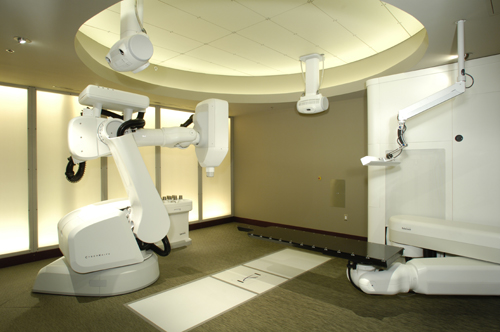A new hope for patients diagnosed with tumours that cannot be treated with conventional radiotherapy methods or require complicated surgical interventions or inoperable tumours.
WHAT IS CYBERKNIFE RADIOCHIRURGY?
CyberKnife radiosurgery is a non-invasive radiotherapeutic treatment that uses high-intensity energy to deliver very precise beams of radiation from various angles. CyberKnife is so precise that the radiation beam can be applied to irregularly shaped tumours, even those near vital organs. This feature allows CyberKnife to be applied in many cases, including those considered inoperable or untreatable by surgical or other treatment methods—offering many patients a new hope for life.
CASES TREATABLE WITH CYBERKNIFE:
CyberKnife is FDA-recommended for treating tumours or lesions anywhere in the body where radiotherapy is indicated. Patients should consult their doctor to determine if CyberKnife is the most suitable treatment for them. Cases that can be treated with CyberKnife include:
- Primary or metastatic brain tumours
- Spinal column tumours
- Spinal cord tumours
- Soft tissue tumours in organs (Lungs, Kidneys, Liver, Pancreas)
- Acoustic neuromas
- Meningiomas/cranial tumours
- Pituitary gland tumours
- Residual or recurrent tumours
- Arteriovenous malformations
- Functional disorders like trigeminal neuralgia
ADVANTAGES OF CYBERKNIFE TREATMENT:
Painless Treatment
There are no pain-associated issues with CyberKnife radiosurgery.
Frameless Treatment
CyberKnife’s ability to correct patient movement eliminates the pain and disadvantages associated with the use of a metal frame used in other stereotactic techniques.
Versatile Treatment
The uniqueness of the CyberKnife design makes it possible to treat lesions or tumours anywhere in the body, representing an entirely new approach to radiosurgery. Radiotherapy can be administered to both the brain and spine, as well as soft tissues such as the lungs, liver, and kidneys.
Outpatient Treatment
Treatment with CyberKnife substantially reduces the risk of complications and the recovery period required after surgical interventions. With CyberKnife, gradual radiosurgery is possible. The total radiation dose can be divided into two to five smaller doses that can be administered over several consecutive days. This property better protects the surrounding tissues of the tumour, beneficial for the treatment of larger tumours or those near sensitive areas. After treatment, most patients can return home and resume normal activities.
HOW DOES CYBERKNIFE WORK?
CyberKnife is a radiation emission system mounted on the flexible arm of a robot that provides access to tumours located anywhere in the body. CyberKnife integrates two high-level technologies:
- An imaging system that verifies the location of the tumour and can automatically compensate for patient movements during radiation emission. This imaging system eliminates the need for mounting a frame for the head (invasive method).
- A source of energy mounted on the robot’s arm, with multiple joints and six degrees of freedom in motion, allowing exceptional manoeuvrability in focusing on tumours. A powerful X-ray source mounted on the robot’s arm precisely locates the tumour in the body and sends point-specific radiation with micrometre precision from more than 1200 angles.
The precision of the CyberKnife system represents a major breakthrough in radiosurgery. The digital radiological imaging system of anatomical fields and implanted markers is used for precise radiation orientation. The radiation beams are focused convergently on the tumour to maximize the amount of radiation reaching the tumour and minimize the exposure of surrounding healthy tissues.
TREATMENT PROCEDURE:
The CyberKnife treatment procedure consists of six steps:
1. Patient Consultation:
The patient’s eligibility for CyberKnife treatment is evaluated by their doctor and our CyberKnife treatment team. Once it is decided that the patient is suitable for CyberKnife treatment, the treatment scheme is established.
2. Treatment Scheme Establishment:
It depends on the treatment protocol. For intracranial treatment, facial masks are used to immobilize the patient and monitor the lesion. For extracranial treatment, small metal or gold markers may be used, or the patient may be equipped with a “Synchrony” tracking vest. The facial mask fitting is non-invasive and painless, unlike the head frame used in previous radiotherapy procedures. If markers are needed, they are small (three to four millimeters long), causing minimal discomfort to the patient. The “Synchrony” tracking vest is used to track dynamic markers that move with breathing.
3. CyberKnife Visualization:
When the patient has been immobilized in the necessary position, and tracking elements have been attached, localization images of the lesion are taken. CT images are necessary but can be rapidly combined with MRI, PET, or 3-D angiography images.
4. Treatment Planning:
After visualization, the patient can leave, and the treatment plan is then established. Doctors and physicists can quickly develop the treatment plan thanks to the calculation speed of the CyberKnife planning system.
5. Treatment Administration:
After the treatment plan is developed, the patient returns for administration. The patient is positioned in a mask or “Synchrony” tracking vest. While the patient lies on the treatment table, the robot arm moves slowly around the patient, precisely locates the position of the target lesion, and emits radiation in real-time from the most suitable angles. Anesthesia is not required. The entire procedure takes only 30-60 minutes, after which the patient is free to return to normal activities.
6. Patient Monitoring:
As with any radiotherapy or radiosurgery treatment, radiological and clinical monitoring of the patient is necessary to track progress.


